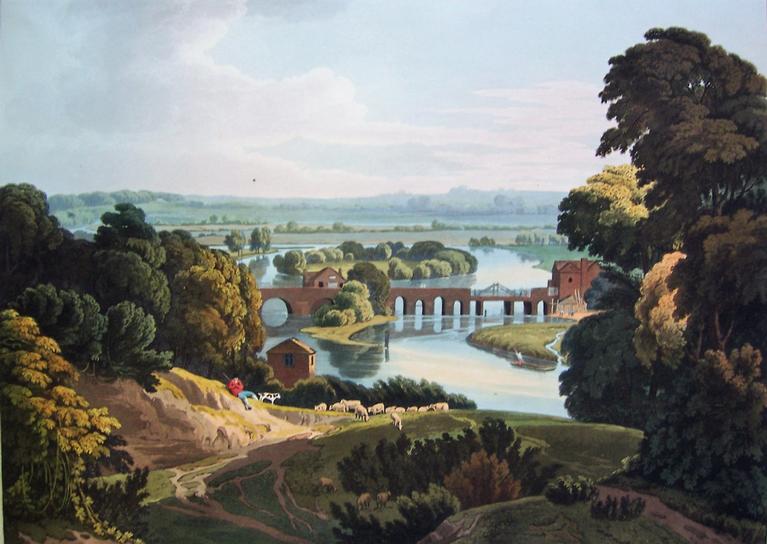Blog
9 February 2022

Various illustrated books in Emmanuel’s collections – devoted to recording the scenery and the observations of travellers along the course of certain rivers – remind us how significant has been the idea of rivers as entities with their own distinct character and culture, as also the history of human engagement with such rivers. From accounts of intrepid Victorians exploring to the source of African rivers to the recent spate of gentle TV programmes that transport their viewers down rivers and even along canals, there is an impetus in common.
The earliest and most influential river-tour in Britain was a boat-trip down the River Wye from Ross-on-Wye to Chepstow, past a series of natural features and scenic buildings and ruins. Although the beauties of the Wye valley had been frequented by tourists for some decades before, the whole tour became a fashionable craze after the publication in 1782 of William Gilpin’s Observations on the River Wye and Several Parts of South Wales etc, relative chiefly to Picturesque Beauty. Emmanuel’s copy of T. H. Fielding’s Illustrations of the River Wye (1822) dates from the height of the craze in the early nineteenth century, with aquatints illustrating the whole course of the Wye from its source and highest reaches in picturesquely rugged Welsh scenery down to the sea. As the grand arbiter of what was picturesque, Gilpin had declared the hill-top ruins of Goodrich Castle, towering high over the river, to be ‘correctly Picturesque’.
.JPG)
Plate 2: Fielding, Illustrations of the River Wye: ‘View of the Wye from Rhayader’; Plate 3: Illustrations: ‘Goodrich Castle, from the Ferry’;
At this period eight or ten tourist boats would leave Ross-on-Wye every day, although some tourists walked the banks of the river. Boats were furnished with drawing tables at which the tourists would sketch the most picturesque views.
.JPG)
Plate 4: Illustrations: ‘View down the River at the New Weir’; Plate 5: Illustrations: ‘North View of Tintern Abbey’;
Awnings provided shelter from the inky skies of picturesque sudden storms recorded here as in other views, and one of the tour’s late highlights were the ruins of Tintern Abbey, made even more famous after publication of Wordsworth’s poem Lines Written a Few Miles above Tintern Abbey, on Revisiting the Banks of the Wye during a Tour, July 13, 1798.
Local and regional patriotisms led to publication of ‘tours’ and ‘descriptions’ of more modest rivers. Picturesque Views on the River Exe (1819) was published in Tiverton and brims with local loyalty to the bosky beauties of the Exe valley, while F. C. Lewis’s Scenery of the River Dart (1821) uses etchings that well catch the rock-strewn moorlands and the wooded Devon valleys through which the Dart flows from its source to the sea.
.JPG)
Plate 6: Views on the River Exe: ‘Oakford Bridge on the Exe’; Plate 7: Scenery of the River Dart: ‘Junction of the River Weber with the Dart’;
The Medway and the Warwickshire Avon received similar treatments, as well as some canals.
By contrast, the various ‘histories’ and ‘picturesque views’ of the Thames attempt ambitious syntheses of extensive prospects of landscape with resonantly historic architecture of national significance. In William Havell’s Picturesque Views of the River Thames (1818) panoramas of the Thames valley, sketched from some very elevated vantage-point and under a golden light, show the river moving through an expansive landscape that extends to a distant horizon. Other views showcase riverside views of towns along the Thames or an imposing building, such as the sheer massiveness of Windsor Castle as depicted here.
.JPG)
Plate 8: Havell: ‘View of the Thames at Streatley’; Plate 9: Havell: ‘Windsor Castle’;
Tourism to Europe could open up again after Waterloo, and Baron Johann Isaac von Gerning’s A Picturesque Tour along the Rhine, from Mentz to Cologne (published in London in 1820) accompanies its beautiful plates with information on topography, history and popular traditions, hoping to attract ‘travellers of cultivated minds who may be induced to visit this interesting portion of Germany,’ which it describes impartially as ‘a portion of heaven fallen down to earth’. Emphasis is on the most picturesque views and prospects, with romantic castles perched high on their crags above the river viewed far below.
.JPG)
Plate 10: Gerning: ‘Thurmberg’; Plate 11: Gerning: ‘Liebenstein and Sterrenberg’;
Or there are views nearer to river level, that by contrast give a perspective looking up at the steep-sided valleys through which the Rhine here flows, with buildings ‘reflected in all their melancholy gloom in the crystal stream’.
.JPG)
Plate 12: Gerning: ‘St Goarshausen, St Goar, and Rheinfels’; Plate 13: Gerning: ‘Salmon Fishery at Lurley’;
The Baron’s book is one of a series of such ‘Picturesque Tours’ advertised by the publisher, Ackerman, which additionally promised tours of the Seine and the Ganges. The latter is a sign of a fascinating extension of interest and taste, which seeks out the Picturesque far beyond European scenery. Emmanuel’s collection also includes the advertised A Picturesque Tour along the Rivers Ganges and Jumna (1824), ‘From Original Drawings Made on the Spot’ by Lieutenant Colonel C. R. Forrest, ‘Late on the Staff of His Majesty’s Service in Bengal’.
.JPG)
Plate 14: Forrest: ‘Ancient Tomb at the Confluence of the Boglipore Nulla and the Ganges’; Plate 15: Forrest: ‘Surseya Ghaut, Khanpore’
Emmanuel’s copy is now very rare, in that it is still unbound in the original ‘paperback’ instalments in which it was received by its subscriber.
Barry Windeatt (Keeper of Rare Books)
Images by Helen Carron (College Librarian)
Back to All Blog Posts
.JPG)
.JPG)
.JPG)
.JPG)
.JPG)
.JPG)
.JPG)